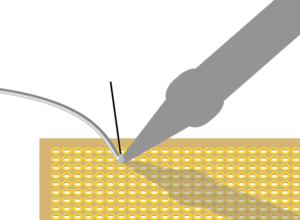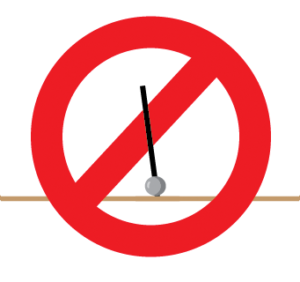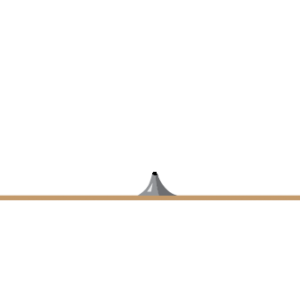Use solder specific for electronics. This solder has a flux core. Flux enables the solder to adhere to a clean metal surface and prevents the formation of oxides.
Do not use soldering liquids. They are very aggressive for both soldering iron and electronics and are not necessary for electronics soldering. They even damage component leads.
Avoid oxidation of the surface, greasy fingerprints won’t help. Use very fine sanding paper to clean the metal surface of your printed circuit board if necessary.
Immobilize the joint: Prevent the component from falling out of the board e.g. by bending the leads.
When starting to solder, check whether the tip of the soldering iron is clean. If needed, clean the tip by poking the iron a few times in a (brass) sponge. A good tip temperature is 360°C. Tinning the iron tip (with a little solder) will improve heat transfer.
Use the tip of the soldering iron to heat the copper on the matrix board and the component lead at the same time.

Continue heating and then apply some solder. Move the end of the solder to the joint so that it contacts both the solder pad and the component lead. Allow it to flow into the joint. It should fill or cover the hole and flow smoothly onto both the solder pad and the pin or component lead. When this is done, first pull back the solder, then the iron while keeping the joint steady during cooling down. It only takes a few seconds to make the perfect joint.
Check the joint. If it looks like one of the bad examples, better rework the joint.


When you don’t preheat the component and the board enough, the solder might not attach to one or the other. This might cause beads or cause components to detach and show unwanted behavior in your circuit.
Heating the component or the board too much will damage them, or form so called ‘cold joints’. Cold joints typically look dull.
Adding too much solder might cause unwanted solder bridges.

If the joint looks dull you should work quicker or you probably moved components or wire during the soldering.

A good joint looks shiny and has a volcano type of shape, which ensures the maximum conducting area and the right amount of solder.
When you are satisfied about the solder joint, use your wire cutter to trim the lead close to the board.
In case you made a mistake or need to make a correction for other reasons, have a look at our tutorial on desoldering.
Safety
- Solder wire contains lead and other heavy metals, which is dangerous. So wash your hands after soldering.
- Use fume extraction. (Not for the metal but for the fumes coming from the so called flux-core.)
- ELCO’s should not be used with ‘reversed polarity’. Although rare; they might explode. So pay attention to the polarity of the terminals.